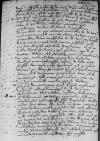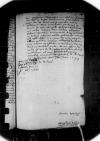Recte factum, quod acta huc misit Reverendissima Dominatio Vestra, quae ego apud me retinebo, ut si venerit homo ille importunus, possiem ea, quae dixerit, refellere. Nam se venturum omnino minatus est, cuiuscumque tandem id faciat suggestione.
De periculo, in quo eramus, nonnulla Reverendissimae Dominationi Vestrae narraveram, sed non ita plene sciebam omnia, quemadmodum in scheda Reverendissima Dominatio Vestra perscripsit. Deus nos servavit, sed parum affuit, quin par pari fuisset relatum ⌊Varssaviae⌋.
Erat in curia regis ⌊syndicus⌋, ipse quidem apud
serenissimam or sacram⌈serenissimamserenissimam or sacram⌉
⌊regiam maiestatem⌋, sed familia eius in impluvio. In eam iecit quidam ingentem laterem, quod si quem attigisset, actum de vita eius fuisset. Hoc ipse mihi ⌊syndicus⌋ est questus, quem ego sum hortatus, ut se familiamque suam sub vesperam praesertim domi suae contineret: esse enim periculum, cum ex nostris nonnulli male accepti ⌊Gedani⌋ fuerint, ne par pari, quod aiunt, referant. Responsi exemplum misi Reverendissimae Dominationi Vestrae per ⌊Mauricium⌋. Per ⌊eundem⌋ mittere statueram et litterarum in ⌊Urbem⌋ exempla, sed ea coactus fui relinquere ⌊maiestati reginali⌋. Mitto autem per ⌊hunc⌋. Dominus ⌊Locka⌋ nusquam comparet, a suis ⌊Gedani⌋ male acceptus. Si certi alicuius hominis potestas dabitur, per eum litteras mitti curabo non expectato illo. Sed nisi sit, qui urgeat, ut postulationi sacrae ⌊maiestatis regiae⌋ fiat satis, frustra erunt scriptae litterae. Cui autem credendum iam sit in ⌊Urbe⌋, nescio. ⌊Conopniczki⌋, metuo, ut iam isthic sit, quo absente nemo est, cui recte committi negotium hoc possit.  BCz 1618, p. 536 Visum est itaque scribere litteras regias ad Reverendissimae Dominationis Vestrae ⌊nepotem⌋, ut ille nomine ⌊maiestatis regiae⌋ negotium hoc sollicitet. Quod si fortasse vitandi periculi causa declinaverit onus hoc, eodem exemplo scribentur aliae absque titulo, ut cui volet inscribi ipse faciat. De domino burgrabio quae hidden by binding⌈[ae]ae hidden by binding⌉ fuit conflata suspicio, eam esse falsam ⌊Gedani hidden by binding⌈[i]i hidden by binding⌉⌋ adhuc cum esset ⌊reverendissimus dominus⌋ cognovit. ⌊Syndicus⌋ neque de moneta, neque de bonis Puczko quicquam impetravit. Rebus infectis redire coactus est, quin etiam designati iam sunt commissarii ad ea bona redimenda, inter quos hidden by binding⌈[os]os hidden by binding⌉ principem locum obtinet Reverendissima Dominatio Vestra. Quod si metuit, ne concitata de se suspicio augeatur hidden by binding⌈[ur]ur hidden by binding⌉ ac maiore apud suos invidia flagrare incipiat, atque ideo provinciam hanc putaverit hidden by binding⌈[rit]rit hidden by binding⌉ detrectandam, extrahi negotium poterit, dum hidden by binding⌈[m]m hidden by binding⌉ quid animi habeat Reverendissima Dominatio Vestra, cognoscamus. Fortasse si renuet, in locum eius quispiam alius renuntiabitur.
BCz 1618, p. 536 Visum est itaque scribere litteras regias ad Reverendissimae Dominationis Vestrae ⌊nepotem⌋, ut ille nomine ⌊maiestatis regiae⌋ negotium hoc sollicitet. Quod si fortasse vitandi periculi causa declinaverit onus hoc, eodem exemplo scribentur aliae absque titulo, ut cui volet inscribi ipse faciat. De domino burgrabio quae hidden by binding⌈[ae]ae hidden by binding⌉ fuit conflata suspicio, eam esse falsam ⌊Gedani hidden by binding⌈[i]i hidden by binding⌉⌋ adhuc cum esset ⌊reverendissimus dominus⌋ cognovit. ⌊Syndicus⌋ neque de moneta, neque de bonis Puczko quicquam impetravit. Rebus infectis redire coactus est, quin etiam designati iam sunt commissarii ad ea bona redimenda, inter quos hidden by binding⌈[os]os hidden by binding⌉ principem locum obtinet Reverendissima Dominatio Vestra. Quod si metuit, ne concitata de se suspicio augeatur hidden by binding⌈[ur]ur hidden by binding⌉ ac maiore apud suos invidia flagrare incipiat, atque ideo provinciam hanc putaverit hidden by binding⌈[rit]rit hidden by binding⌉ detrectandam, extrahi negotium poterit, dum hidden by binding⌈[m]m hidden by binding⌉ quid animi habeat Reverendissima Dominatio Vestra, cognoscamus. Fortasse si renuet, in locum eius quispiam alius renuntiabitur.
Ego heri ⌊reverendissimum dominum⌋ reliqui hidden by binding⌈[ui]ui hidden by binding⌉ in ⌊Brock⌋, cras cogito in ⌊Bielsco⌋. Negant aliqui longius progressuram
s(erenissimam) or s(acram)⌈s(erenissimam)s(erenissimam) or s(acram)⌉
⌊maiestatem regiam⌋, sed inde in ⌊regnum⌋ redituram dicunt, idque ineunte hidden by binding⌈[nte]nte hidden by binding⌉ autumno. Quod ut ita eveniat, Deum precamur hidden by binding⌈[ur]ur hidden by binding⌉. Est enim, ut fertur, in ⌊Lituania⌋ incredibilis annonae caritas, ut homines etiam fame moriantur, pro equis pabulum non reperitur, summa est rerum omnium difficultas.
De ⌊eo⌋, cuius nuptiis[1] interfuit Reverendissima Dominatio Vestra superiore anno, bona spes est. Adiecisse dicitur animum ad hidden by binding⌈[d]d hidden by binding⌉ angelicam ⌊uxoris⌋ formam. Laeta nobis omnia promittuntur. Confirmet ea Deus.
Ex ⌊Hungaria⌋ novi nihil praeter Turcicos terro<re>s. Quamquam ⌊caesarem⌋ ipsum hoc anno venturum negant. Cepisse dicuntur ⌊Vissegradum⌋ ⌊Turcae⌋, Nitram  BCz 1618, p. 537 vero oppugnare.
BCz 1618, p. 537 vero oppugnare.
⌊Monachus⌋ non obscure favere iam dicitur ⌊regis Romanorum⌋ partibus. Spero fore ut brevi non p ingrata nova audiamus. Quae priusquam prodeant in lucem, ut certi aliquid habeamus, scribere non audeo. Utinam vero iustum aliquem haberet exercitum ⌊Romanorum rex⌋, felicius ei fortasse caderent multa multorum opinione. Sed nihil adhuc in eo praesidii esse, neque ullam militum manum collegisse videtur, cum interim grassentur in ⌊Hungaria⌋ ⌊Turcae⌋. Deus misereatur nostri.
Quem precor, ut Vestram quoque Reverendissimam Dominationem quam diutissime servet incolumem et omni felicitatis genere cumulet.
Commendo me gratiae Reverendissimae Dominationis Vestrae.
 BCz 1618, p. 536 Visum est itaque scribere litteras regias ad Reverendissimae Dominationis Vestrae
BCz 1618, p. 536 Visum est itaque scribere litteras regias ad Reverendissimae Dominationis Vestrae  BCz 1618, p. 537 vero oppugnare.
BCz 1618, p. 537 vero oppugnare.



